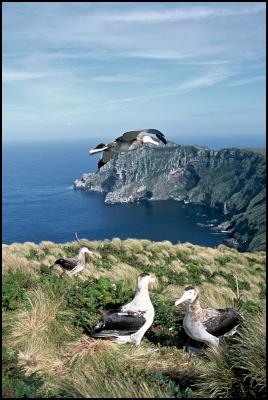Marine life likely to benefit from protection
3 June 2008
Marine life likely to benefit from further protection in the seas around the Subantarctic Islands

Click for big version
© Photo courtesy of Tui De Roy / DOC.
The sea around New Zealand’s Subantarctic Islands is recognised as a World Heritage Area and is likely to receive a boost in protection from a review of marine protected areas in the region.
The Government has set up the Subantarctic Marine Protection Planning Forum to review existing protection afforded to marine environments in New Zealand’s Subantarctic region. The Forum will make recommendations to Ministers for new protected areas to implement the Government’s Marine Protected Areas Policy. The Forum is jointly facilitated by the Department of Conservation and the Ministry of Fisheries.
Recommendations will be considered in two phases. Phase One will look at protection options for the Territorial Seas (within the 12 nautical mile limits) of the Campbell/Motu Ihupuku, Antipodes and Bounty Islands. The Auckland Islands will also be considered by the Forum, although their territorial waters are already fully protected by marine reserve and a marine mammal sanctuary.
Phase Two will look at protection options for the offshore marine environments in the Subantarctic biogeographic region.
“The Subantarctic Islands, and the waters surrounding them, have World Heritage Status under UNESCO. The focus of the Forum will be to ensure that adequate protection is afforded to the habitats and ecosystems that together characterise the marine environments of the region,” says independent Forum chair, Paul Beverley.
“Each island contains many species that are found or breed at no other location in the world, and depend upon the sea. These include the endangered New Zealand sea lion and a number of species of sea birds, such as the Antipodes wandering albatross, and the Campbell Island and Bounty Island shags. There are literally dozens of seaweed species and invertebrates which are endemic (not found anywhere else) in the waters around these island groups.”
The interdependence of land and sea in the Subantarctic is exemplified by the Bounty Island shag which gathers Marginariella seaweed to build its nests. Neither species is found anywhere else in the world. The biological diversity of the New Zealand Subantarctic region is considered by some to be comparable to the Galapagos Islands.
“Some of the waters around the Subantarctic islands are also important as fishing grounds for New Zealand’s commercial fishing industry. The Forum’s primary role is to protect the biodiversity associated with these islands whilst minimising the impact of that protection on existing users, such as fishers,” says Mr Beverley.
The Forum is well underway following four successful meetings in Wellington this year. Mr Beverley says “The Forum is made up of representatives from key groups with an interest in the region, including tangata whenua, the fishing industry, science organisations and non-government organisations; all are working well together. There has been robust debate about the scientific, conservation and use values around these islands.”
Recommendations produced by the Forum will be released for public consultation in June or July this year. The Forum will consider the responses to their consultation document before reporting to Conservation Minister Steve Chadwick and Fisheries Minister Jim Anderton later this year.
For more information about the Subantarctic Marine Protection Planning Forum go to http://www.biodiversity.govt.nz/seas/biodiversity/protected/mpa_consultation.html
ENDS


 Air New Zealand: Air New Zealand And Cathay Pacific Welcome New Zealand Ministerial Approval To Extend Partnership
Air New Zealand: Air New Zealand And Cathay Pacific Welcome New Zealand Ministerial Approval To Extend Partnership Bill Bennett: Spark looks to bigger phone bundles for ARPU refresh
Bill Bennett: Spark looks to bigger phone bundles for ARPU refresh Greenpeace: New Anchor Butter Owner Must Go Palm Kernel-free
Greenpeace: New Anchor Butter Owner Must Go Palm Kernel-free Science Media Centre: What To Expect From COP29 – Expert Reaction
Science Media Centre: What To Expect From COP29 – Expert Reaction Infrastructure New Zealand: Unlocking ‘Lazy’ Capital To Build New Infrastructure For Our Future
Infrastructure New Zealand: Unlocking ‘Lazy’ Capital To Build New Infrastructure For Our Future Parrot Analytics: Paramount Earnings - Can Ellison Strike The Right Balance?
Parrot Analytics: Paramount Earnings - Can Ellison Strike The Right Balance?



